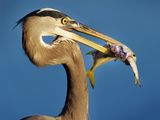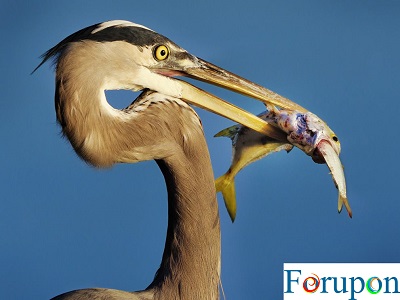Food Chain
The food chain describes who eats whom in the wild.
Secondary Consumers
For upon |A fish, caught by a heron in Nokomis, Florida, has another fish in its mouth. These secondary consumers in the food chain prey on other organisms. Producers, such as plants, create their nutrients, while primary consumers, also called herbivores, rely on producers for food.
Kelp Close-Up
Giant kelp, like this specimen growing in a kelp forest near Santa Catalina Island, California, is a type of seaweed. Seaweeds are algae. Algae, along with plants and some bacteria and fungi, are autotrophs. Autotrophs are the producers in the food chain, meaning they create their nutrients and energy. Kelp, like most autotrophs, creates energy through a process called photosynthesis.
Honeybee
A honeybee gathers pollen from a flower. Honeybees are palynivores, a type of primary consumer (herbivores) that eat only pollen.
Ankole Cattle
Long-horned Ankole cattle graze in a pasture in Uganda. Ankole cattle are herbivores that have adapted to survive on the nutrient-poor grasses of the African bush.
Sundew
A fruit fly is trapped in the sticky tentacles of a sundew plant. Sundews are carnivores, meaning they consume other organisms for food.
Hyena
Hyenas are a specialized type of carnivore called a scavenger. Scavengers consume the bodies of animals the scavenger did not kill. Most hyenas are also hunters.
Mushroom on Stump
Mushrooms grow on a tree stump in Gifford Pinchot National Forest, Washington. Mushrooms and other fungi are detritivores. Detritivores obtain nutrients from decomposing material. They play an important role in the food chain by breaking down nutrients and serving as food sources for many consumers.
The food chain describes who eats whom in the wild. Every living thing—from one-celled algae to giant blue whales—needs food to survive. Each food chain is a possible pathway that energy and nutrients can follow through the ecosystem.
For example, grass produces its food from sunlight. A rabbit eats the grass. A fox eats the rabbit. When the fox dies, bacteria break down its body, returning it to the soil where it provides nutrients for plants like grass.
Of course, many different animals eat grass, and rabbits can eat other plants besides grass. Foxes, in turn, can eat many types of animals and plants. Each of these living things can be a part of multiple food chains. All of the interconnected and overlapping food chains in an ecosystem make up a food web.
Trophic Levels
Organisms in food chains are grouped into categories called trophic levels. Roughly speaking, these levels are divided into producers (first trophic level), consumers (second, third, and fourth trophic levels), and decomposers.
Producers, also known as autotrophs, make their food. They make up the first level of every food chain. Autotrophs are usually plants or one-celled organisms. Nearly all autotrophs use a process called photosynthesis to create “food” (a nutrient called glucose) from sunlight, carbon dioxide, and water.
Plants are the most familiar type of autotroph, but there are many other kinds. Algae, whose larger forms are known as seaweed, are autotrophic. Phytoplankton, tiny organisms that live in the ocean, are also autotrophs. Some types of bacteria are autotrophs. For example, bacteria living in active volcanoes use sulfur compounds to produce their food. This process is called chemosynthesis.
The second trophic level consists of organisms that eat the producers. These are called primary consumers, or herbivores. Deer, turtles, and many types of birds are herbivores. Secondary consumers eat the herbivores. Tertiary consumers eat the secondary consumers. There may be more levels of consumers before a chain finally reaches its top predator. Top predators, also called apex predators, eat other consumers.
Consumers can be carnivores (animals that eat other animals) or omnivores (animals that eat both plants and animals). Omnivores, like people, consume many types of foods. People eat plants, such as vegetables and fruits. 1We also eat animals and animal products, such as meat, milk, and eggs. We eat fungi, such as mushrooms. We also eat algae, in edible seaweeds like nori (used to wrap sushi rolls) and sea lettuce (used in salads).
Detritivores and decomposers are the final part of food chains. Detritivores are organisms that eat nonliving plant and animal remains. For example, scavengers such as vultures eat dead animals. Dung beetles eat animal feces.
Decomposers like fungi and bacteria complete the food chain. They turn organic wastes, such as decaying plants, into inorganic materials, such as nutrient-rich soil. Decomposers complete the cycle of life, returning nutrients to the soil or oceans for use by autotrophs. This starts a whole new food chain.
Food Chains
Different habitats and ecosystems provide many possible food chains that make up a food web.
In one marine food chain, single-celled organisms called phytoplankton provide food for tiny shrimp called krill. Krill provides the main food source for the blue whale, an animal on the third trophic level.
In a grassland ecosystem, a grasshopper might eat grass, a producer. The grasshopper might get eaten by a rat, which in turn is consumed by a snake. Finally, a hawk—an apex predator—swoops down and snatches up the snake.
In a pond, the autotroph might be algae. A mosquito larva eats the algae, and then perhaps a dragonfly larva eats the young mosquito. The dragonfly larva becomes food for a fish, which provides a tasty meal for a raccoon.

The heron and the fish are links in the food chain.
Photograph by Ernie Aranyosi, MyShot
Carnivorous . . . Plants?
Most plants on Earth take energy from the sun and nutrients from the soil. A few plants, however, get their nutrients from animals. These carnivorous plants include pitcher plants, Venus flytraps, and bladderworts. These plants attract and trap prey usually insects and then break them down with digestive enzymes.
Links in the Chain
Organisms consume nutrients from a variety of different sources in the food chain.
- Xylophages eat wood. Termites and bark beetles are xylophages.
- Coprophages eat animal feces. Dung beetles and flies are coprophages.
- Geophages eat earth, such as clay or soil. Parrots and cockatoos are geophages.
- Palynivores eat pollen. Honeybees and some butterflies are palynivores.
- Lepidophages are fish that eat the scales (but not the body) of other fish. Some piranha and some catfish are Lepidophages.
- Macrophages eat mucus. Usually, these tiny organisms live in the gills of fish.
The article was originally published here.


Comments are closed.